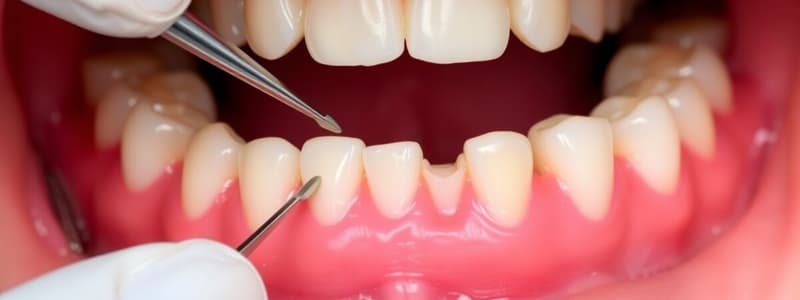Podcast
Questions and Answers
What does a negative number indicate when determining the level of the free gingival margin?
What does a negative number indicate when determining the level of the free gingival margin?
- The gingival margin is at the same level as the CEJ.
- The gingival margin is apical to the CEJ.
- The gingival margin is receding away from the CEJ.
- The gingival margin is significantly covering the CEJ. (correct)
What is Clinical Attachment Level (CAL) used to determine?
What is Clinical Attachment Level (CAL) used to determine?
- The depth of the gingival pockets.
- The true periodontal support around a tooth. (correct)
- The distance between the gingival margin and the CEJ.
- The amount of inflammation present around a tooth.
Which of the following best characterizes inflammation in the case of gingivitis?
Which of the following best characterizes inflammation in the case of gingivitis?
- Presence of clinical attachment loss.
- Recession of the gingival margin.
- No clinical attachment loss. (correct)
- Increased probing depth.
When is the gingival margin considered to be in a normal state?
When is the gingival margin considered to be in a normal state?
What critical element is measured from the CEJ to help distinguish between gingivitis and periodontitis?
What critical element is measured from the CEJ to help distinguish between gingivitis and periodontitis?
What is defined as the distance from the gingival margin to the bottom of the pocket?
What is defined as the distance from the gingival margin to the bottom of the pocket?
What is the standardized diameter of a periodontal probe tip used for probing depth measurements?
What is the standardized diameter of a periodontal probe tip used for probing depth measurements?
Which component is NOT part of the six-point pocket chart for pre-treatment periodontal assessment?
Which component is NOT part of the six-point pocket chart for pre-treatment periodontal assessment?
What is a common limitation of periodontal probing that practitioners should be aware of?
What is a common limitation of periodontal probing that practitioners should be aware of?
What does the Clinical Attachment Level indicate in periodontal assessments?
What does the Clinical Attachment Level indicate in periodontal assessments?
In the six-point pocket chart, how is the deepest reading determined?
In the six-point pocket chart, how is the deepest reading determined?
Why is the ergonomics of gripping the periodontal probe important?
Why is the ergonomics of gripping the periodontal probe important?
Which aspect is NOT essential when measuring the free gingival margin during a periodontal assessment?
Which aspect is NOT essential when measuring the free gingival margin during a periodontal assessment?
Flashcards
Probing Depth
Probing Depth
Distance from the gingival margin to the bottom of the pocket.
6-Point Pocket Chart
6-Point Pocket Chart
Records probing depth measurements at six specific points around each tooth.
Free Gingival Margin
Free Gingival Margin
The edge of the gingiva that surrounds the tooth; can be natural, coronal, or apical to the CEJ.
Positive Number (+’ve)
Positive Number (+’ve)
Signup and view all the flashcards
Clinical Attachment Level (CAL)
Clinical Attachment Level (CAL)
Signup and view all the flashcards
Gingivitis
Gingivitis
Signup and view all the flashcards
Periodontitis
Periodontitis
Signup and view all the flashcards
Calculating CAL
Calculating CAL
Signup and view all the flashcards
Study Notes
Probing Depth
- The probing depth is the distance from the gingival margin to the bottom of the pocket.
- Measuring is done with a graduated periodontal probe with a standardized tip diameter (0.4mm - 0.5mm).
- The probe diameter is important because it affects the accuracy of the measurement.
6 Point Pocket Chart (Pre-treatment Periodontal Assessment)
- The six points record probing depth measurements around a tooth:
- Distobuccal line angle to midline of the distal surface
- Buccal surface
- Mesiobuccal line angle to mesial surface
- Distolingual line angle to distal surface
- Lingual surface
- Mesiolingual angle to midline of mesial surface
Free Gingival Margin
- The free gingival margin is the edge of the gingiva that surrounds the tooth.
- The level of the free gingival margin can be:
- Natural position (0): The gingival margin is slightly coronal to the CEJ.
- Negative number (-’ve): The gingival margin significantly covers the CEJ.
- Positive number (+’ve): The gingival margin is apical to the CEJ.
- Recession is charted as a positive number.
- The distance between the CEJ and the gingival margin is measured to determine if the gingival margin is coronal or apical to the CEJ.
Clinical Attachment Levels (CAL)
- CAL is a measure of true periodontal support around a tooth.
- It provides an estimate of true periodontal stability and loss of support for a tooth.
- CAL is measured from the CEJ.
- CAL is critical in distinguishing between gingivitis and periodontitis:
- Gingivitis: Inflammation with no clinical attachment loss.
- Periodontitis: Inflammation with clinical attachment loss.
Calculating CAL
- To calculate CAL:
- Probing depth
- Level of the free gingival margin (0, + or -)
- (+) if the free gingival margin is apical to the CEJ.
- **(-) **if the gingival margin is coronal to the CEJ.
- Combine these two values to get the CAL measurement.
Studying That Suits You
Use AI to generate personalized quizzes and flashcards to suit your learning preferences.



